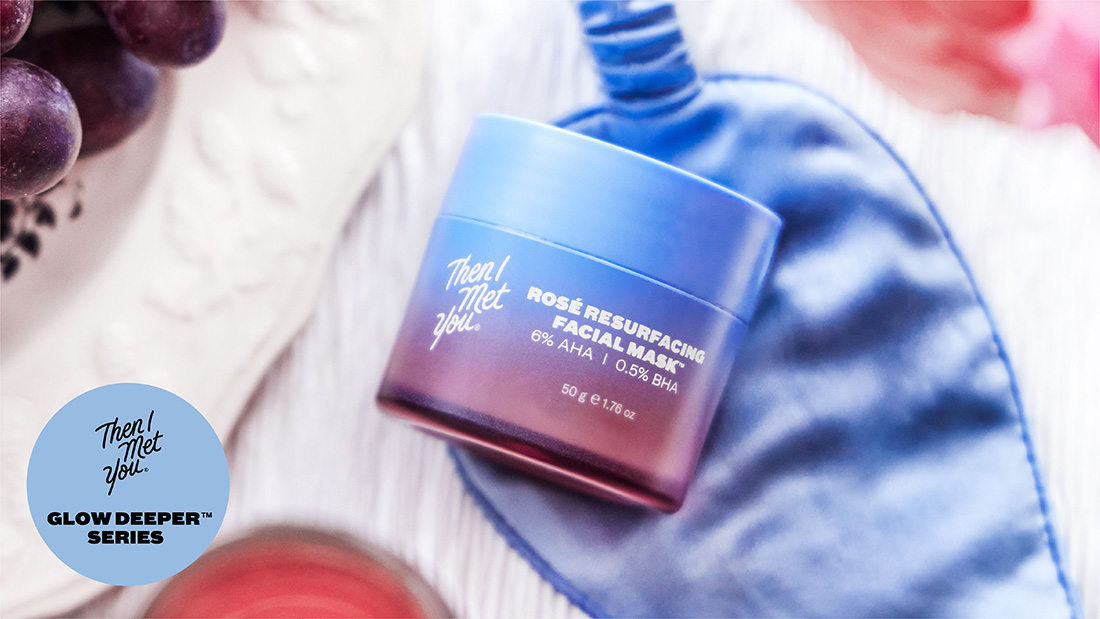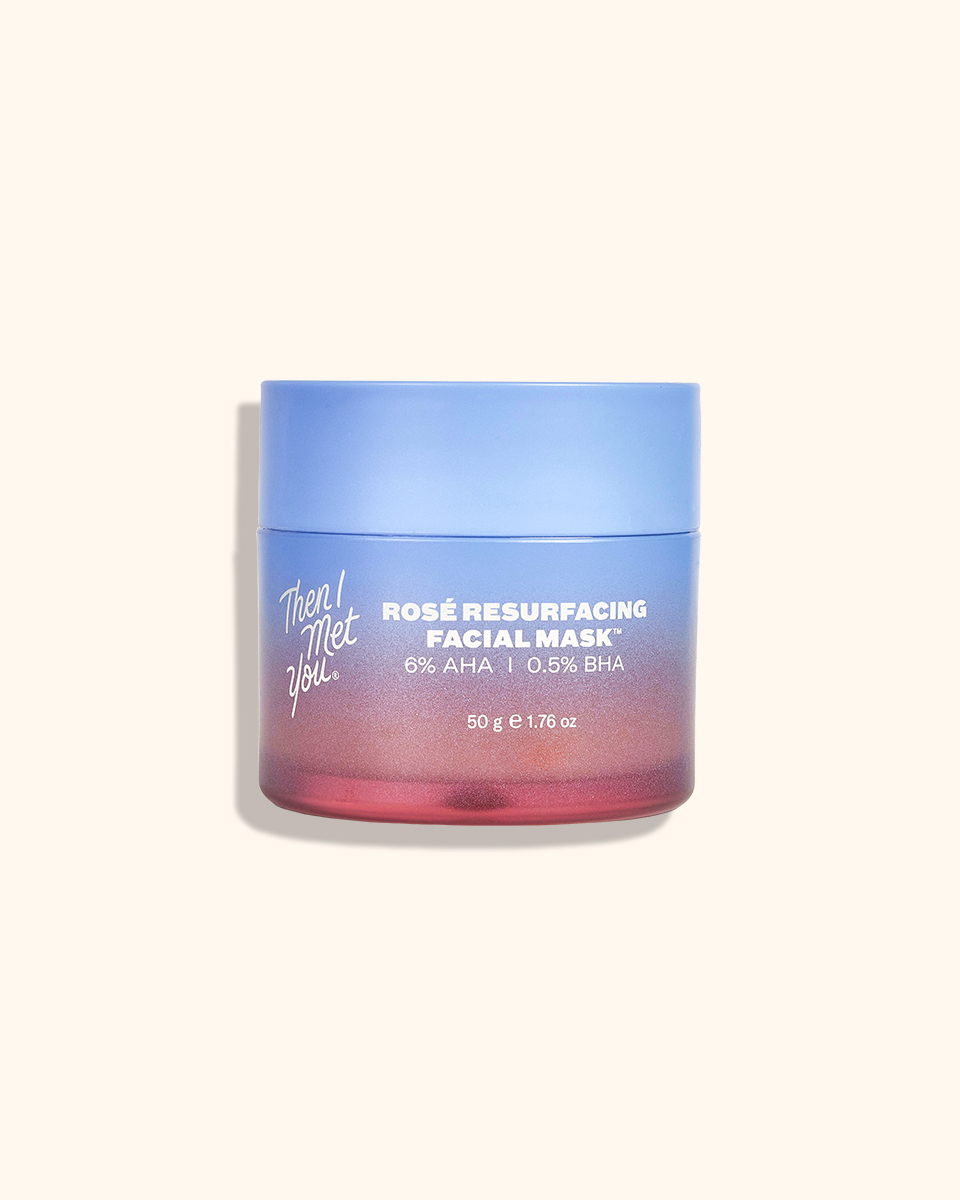Responsible and educated acid mixing is in.
We here at The Klog are always looking for products that promote exfoliation, without causing irritation. The formulation of the Rosé Resurfacing Facial Mask by Then I Met You, successfully addresses both of these skin concerns with a gentle, resurfacing formula tough enough to remove dead skin cells, without causing irritation to the skin.
Here, we dive deep into the benefits of the trio of AHA-BHA acids, antioxidant-rich resveratrol, and damask rose petals, which are the hero ingredients found inside this transformative sparkling facial.
PS: Did you know that rose petals and resveratrol (which is found in wine btw!) not only help your skin achieve a rosy glow, but also provide hydration and antioxidant protection? Find out more about how this ingredient duo only amplifies the benefits of this sparkling resurfacing facial below.

What Are AHA and BHA Acids and How do They Work?
The Then I Met You Rosé Resurfacing Facial Mask utilizes a trio of acids in it’s signature 6% AHA | 0.5% BHA Rose Complex. These expert exfoliators include glycolic and lactic acids which are commonly known alpha-hydroxy acids (AHAs). Salicylic acid, which is a beta-hydroxy acid (BHA), is also incorporated into the mask to round out the effective trio.
Like other acids (tartaric, malic, etc.) found in the AHA family, glycolic and lactic acids are incorporated into cosmetic products to smooth fine lines and surface wrinkles, improve skin texture and tone, and unblock and cleanse the pores, according to the U.S. Food & Drug Administration. They’re multi-purpose ingredients that shoulder quite a bit of work!
AHA-containing products work by promoting exfoliation, which causes dead skin cells to shed from the surface layer of the skin. Once the surface layer is removed from the skin, smooth and softer skin is usually the result, says the FDA. We all love a glowing, soft complexion.
While AHAs are effective, they can cause some irritation for those who have sensitive skin types. This is why the at-home sparkling facial incorporates beta-hydroxy acid (salicylic acid) in its acid blend.
This BHA is effective in reducing the appearance of fine lines and wrinkles, and improving overall skin texture without causing irritation to the skin, according to the FDA. Seeing as its chances of irritation are lower, it makes complete sense that this acid was included in the Rosé Resurfacing Facial Mask’s formulation.
There’s a lot of confusion about using AHAs and BHAs together. Let us clear this up for you! AHA and BHA skin care acids can be used together, says Dr. Jeannette Graf, MD, board-certified dermatologist, and assistant clinical professor of dermatology at Mt Sinai School of Medicine. This combination of acids only helps to improve upon any skin needs and concerns, she explains.
“Combining AHA and BHA together is a good combination – of course the formulation has to be well balanced,” Dr. Graff tells The Klog. “AHAs are water soluble, which are outer skin exfoliants that can remove excess dead surface cells. BHAs are also exfoliants. However, they are oil-soluble which makes them ideal for clogged oily pores and acne prone skin.”
They seem like the perfect acid skin care match.
What is Resveratrol and How Does It Work?
In addition to AHA and BHA acids, the Then I Met You at-home wash-off facial also incorporates resveratrol into its formula.
This ingredient may bring thoughts of your favorite after-dinner beverage to mind. In fact, it’s present in your favorite bottles of red and rosé wine! This is because this powerful antioxidant is found in the skin of red grapes.
Beyond wine, resveratrol has been used in cosmetics and dermatology for years, according to a 2019 study published in The Journal of Cosmetic and Laser Therapy.
As an antioxidant, resveratrol works to protect skin cells against oxidative damage caused by UV radiation, and the slow down of the photoaging process of the skin.
Resveratrol’s benefits don’t stop there! They also include the stimulation of collagen levels, penetration of the skin barrier, anti-aging activity, as well as anti-inflammatory, and antimicrobial properties.
What is Damask Rose and What Can It Do For Your Skin?
Damask rose is the final ingredient incorporated into the resurfacing mask formula. This ingredient is sourced from the extract of damask rose petals, a plant within the rose family.
“Damask rose (Rosa Damascena) has been known to have numerous health benefits for years,” Dr. Graf says. “It is one of the most widely used sources of rose oil that has anti-inflammatory and antiseptic properties. Damask rose can also help hydrate dry skin, clear acne, provide anti-aging effects, minimize textured skin, improve pigmentation, and help people who suffer from eczema and rosacea.”
In the Rosé Resurfacing Facial Mask, luxurious Damask rose petals are used to hydrate and strike balance within the AHA-BHA Rose Complex. While the acids exfoliate, the petals hydrate and nourish the skin barrier!















